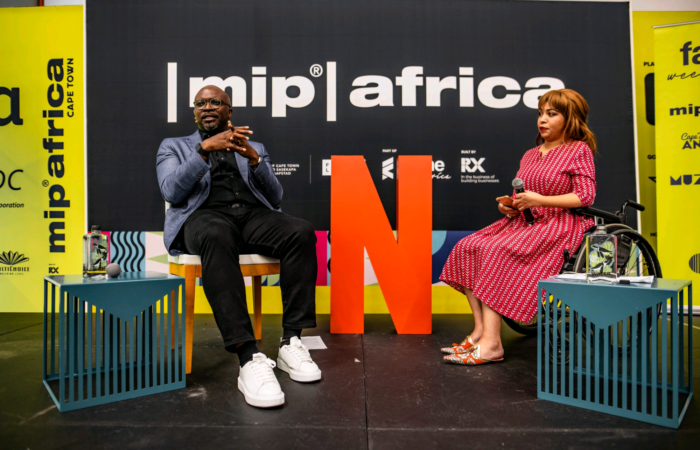he term has long come to be used to describe Nigerian films, but the industry has come a long way from where it first started.

Over the past few years, there has been a massive export of various fragments of Nigerian culture across various parts of the world. This is evident in Nollywood, Nigeria’s vibrant film industry, which has, over the years, etched its indelible mark on the global cinematic stage, earning acclaim for its dynamic storytelling, cultural richness, and unparalleled impact.
It’s not uncommon to find some of the country’s biggest stars on international stages, and Nollywood films have been a prevalent source of internet gifs and memes since at least 2019. This is a testament to how global and popular the industry is.
But before Nollywood became the colossal cinematic empire worth over $6.4 billion, it had humble beginnings. OkayAfrica takes a deep dive into the fascinating evolution of Nollywood and what it’s become today.

NOLLYWOOD’S ORIGIN STORY
Nigeria’s film industry dates back to a time when colonial filmmakers produced films for local audiences. These films, such as Palaver (1926) and Sanders of the River (1935), cast Nigerian actors in speaking roles and were shown in halls nationwide to teeming audiences. During this era, religion played a huge role in the expression of cinema culture, as the Christian missionaries used filmmaking for propaganda.
With time, cinema became a common feature of social life, particularly in Lagos. This development established big commercial cinema houses with branches in strategic parts of the country. Between the 1930s and 1940s, cinema came in the form of playing companies and traveling theater troupes. These plays, funded by the court, church, or audiences, were promoted via adverts and posters disseminating information to potential audiences. The introduction of technology allowed these plays to be recorded, and screened in tiny picture houses across cinemas in the country.

Following Nigeria’s independence in 1960, the film industry quickly grew, creating new film theaters, and ushering in the Golden Age of Nigerian cinema. However, there was a significant influx of American, Indian, and Chinese films — theaters were overwhelmed with adverts for these films, and their stars rose to fame in Nigeria. While this period saw the rise of foreign films, it also helped propagate film culture alongside the oil boom in the 1970s.
Concerned about the invasion of foreign culture in Nigeria, Yakubu Gowon, the then-head of state, issued the Indigenization Decree in 1972. The ruling mandated that 300 film theaters be given back to Nigerians by their foreign owners. As a result of this policy, more Nigerians began to take prominent roles in films, and famous local plays and books were turned into motion pictures. The sector had also gained popularity, and foreign investments helped build film theater complexes like the National Arts Theatre, which had two theaters and could seat over 700 people. At this time, the film industry had grown to be a significant employer of labor, and served a crucial social purpose as Nigerians went to the theaters for pleasure. Because of the country’s rising purchasing power, many Nigerians had more income to spare on home television sets and movie tickets.

HOW DID NOLLYWOOD CHANGE?
As more households could afford televisions, greater focus was placed on this medium. Producers started broadcasting local popular theater shows, first on television and subsequently on video, because the legislation had restricted the amount of foreign content that could be broadcast on television. As a result, a small-scale, unregulated video trade emerged, eventually giving rise to the 1990s video boom that was the subject of considerable discussion.
As a result of the dramatic collapse in film culture, some theaters that had already been built were bought by religious organizations and converted into churches, while others were simply shut down. Only a few formerly thriving film theaters were in business in the early 1990s, and most had shut down by 1999.

It became common to see video copies of television programs sold on the street. The video films were famously available at Alaba International Market, a commercial district in Lagos that was the hub of video distribution, and eventually the hub of piracy in Nigeria. Then came the video rental clubs, which thrived, as films were exchanged for as low as fifty naira.
“When I was growing up in the early aughts, there was a video film rental club in the form of a store close to our family home at Ifako, Lagos,” says Nwokedi Kenechukwu, a culture writer living in Lagos. “The club would give you a membership card, and let you borrow all kinds of Nollywood and Hollywood films in the form of VHS tapes and CDs at very cheap prices”
There were reportedly over 6,000 registered video parlors and even more unregistered ones in 2007. It was also estimated that 522 billion naira (US$3 billion) was made in annual sales revenue from Nigeria’s film business, including 250 billion naira (US$1.6 billion) from broadcast programming.
In 2008, when the video age was at its peak, the industry released almost 200 video films monthly, making it the second-largest maker of films anywhere in the world. However, this era soon saw a decline due to various factors such as piracy, insufficient distribution networks, and a lack of support from the government.

WHERE IS NOLLYWOOD TODAY?
The cinema made a resurgence much later, with Nigeria witnessing an increase in theaters located in affluent cities and in well-known, bustling malls where other commercial activities took place. The Silverbird Group, one of the significant pioneers of this era, erected a theater with the same name at their upscale mall on Victoria Island. When they became wildly successful, more theaters appeared, and spread into the city’s less affluent areas.
A new generation of filmmakers, some of whom had training in filmmaking, also emerged in the 2000s. This was reflected in their films, such as The Figurine(2009), Ijé (2010), and The Wedding Party (2016). Compared to films produced before the video boom, these stood out for their greater narrative complexity, aesthetic value, and general production quality. They had larger budgets, felt more sophisticated than older films, took longer to produce, and appeared to explore stories beyond providing audiences with a didactic moral lesson.
There are significant differences between old and more recent Nollywood films. “I appreciate that new Nollywood is more daring about its storytelling,” says Samson Toromade, an editor for Pulse Nigeria. “But I need to watch films that provoke strong feelings I can remember two or twenty years later, just based on how well I can relate the story to what’s happening around me, outside the screen. Old Nollywood did that better.”

THE IMPACT OF STREAMING
The emergence of technology and its improvements came into play as the world and essential stakeholders began to pay greater attention to the industry. Before the advent of streaming, cinemas were the primary distribution channel for Nollywood films. Most of these films would frequently remain in cinemas for weeks or months, depending on how profitable they were. Then came streaming which allowed fans to connect with these films at their own convenience.
Streaming proved to be an appropriate avenue for people who may have missed a theatrical release or are new to Nollywood. It all began with Mary Remmy Njoku‘s iROKOtv, which boasted several well-known films on its platform, and created several original movies and TV shows.
Early on, Netflix was one of the streaming services to prioritize hosting Nigerian titles on their service. Before the international streamer’s launch in 2020, the company had some Nigerian films and collaborated with established filmmakers. However, the launch also felt like a way for the company to establish a foothold as a significant player in the booming film industry. Soon after, Amazon’s Prime Video came along, and more streamers began teasing and investing in local content. The last few years have seen both streaming giants steadily growing their subscriber bases in Nigeria, with both companies fighting for dominance in the Nigerian market. Their presence has also been crucial to the growth of the industry. Since entering the Nigerian Nollywood market in 2016, Netflix has committed $23.6 million to more than 250 locally-produced, co-produced, and commissioned video content.
Additionally, streaming has been a catalyst for Nigerian filmmakers to think outside the box when crafting stories, seeing as their films now reach a global audience and open them up to broader critique. Director Fiyin Gambo, who made Prime Video’s The Blood Covenant, sees this as “a double-edged sword,” but adds, “it definitely helps us as filmmakers have a global outlook. When “The Wait” got released on Netflix in January 2023, I got messages from all over the world and people reached out to collaborate on future projects,” he told OkayAfrica.
According to PwC, the Nigerian film business generated 2.3% of the country’s GDP, or 239 billion naira ($660 million), in 2021. The company forecasts that it will generate $1 billion in export income. Beyond the revenue brought in is the prestige of global acclaim. One of the biggest goals for the industry is to win an Academy Award for International Feature Film. In the past, South Africa and Algeria have made the nomination shortlist for this highly coveted category, but Nollywood has yet to bag a nomination, despite submitting some of its more impressive work, such as Lionheart (2020) and The Milkmaid (2021).
While some of the most popular Nollywood titles still compete with international blockbusters for a share of the box office, more work still needs to be done, and filmmakers know it. With increasing investment from various companies interested in mining Nigerian stories and exposing them to a global audience, Nollywood certainly has a bright future. Hopefully, it’s one that many people get to partake in.
CREDIT: OkayAfrica










